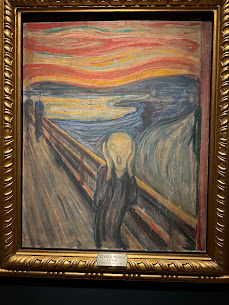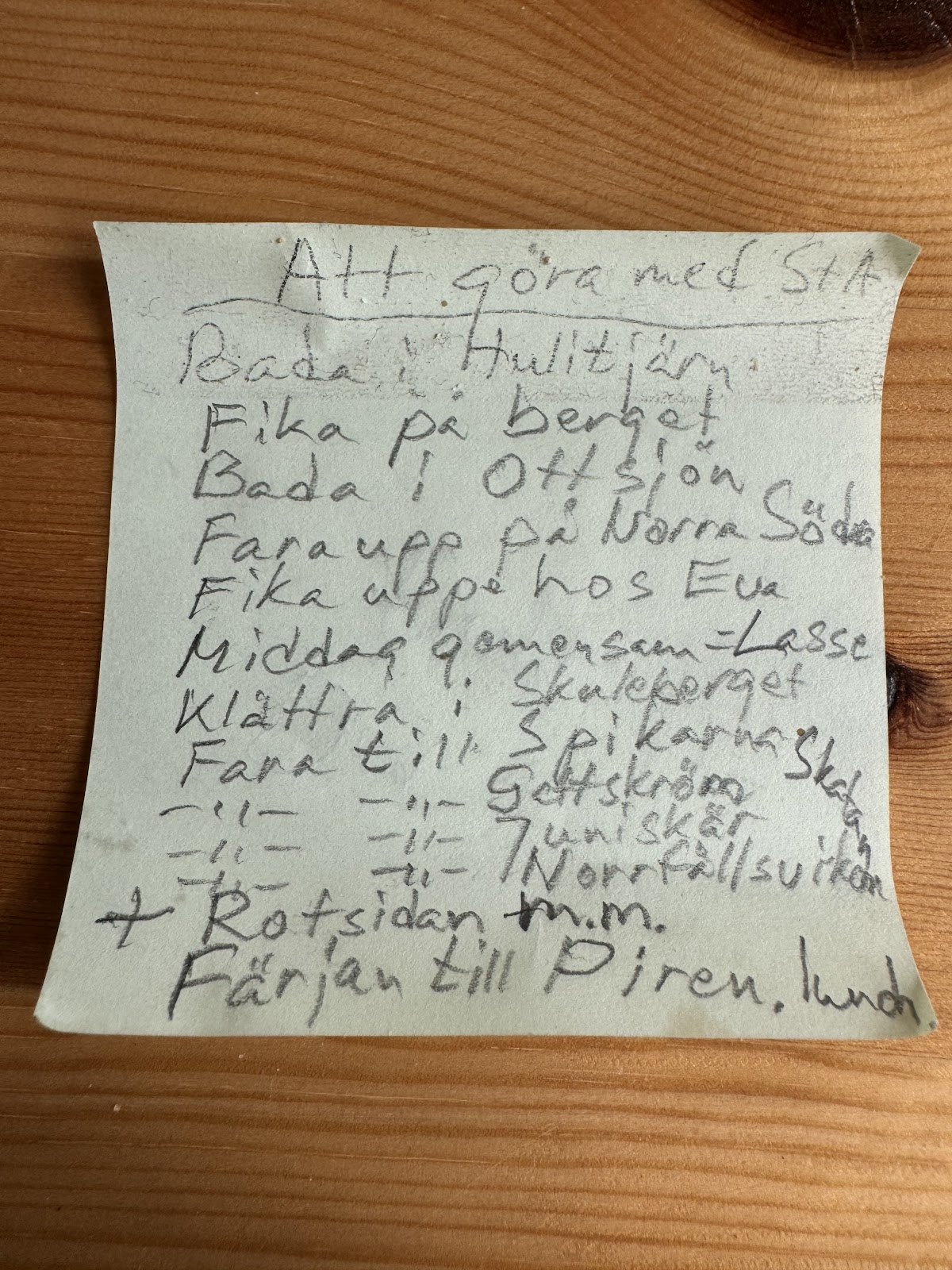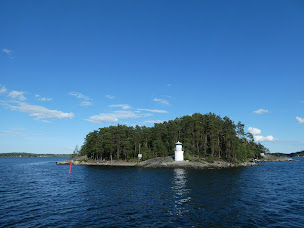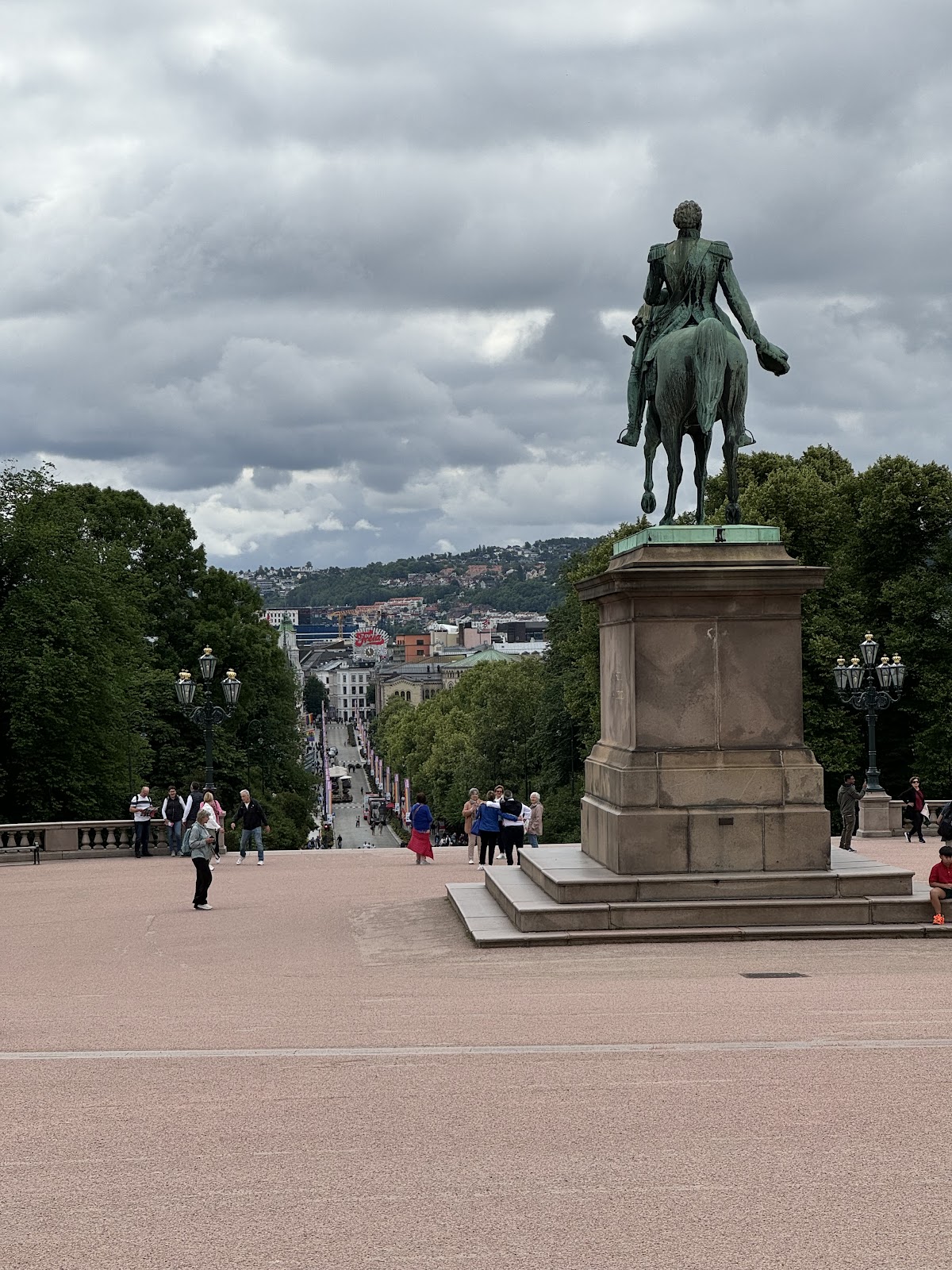Time to explore Oslo
We knew our way around the
railway station and the city so joined the throng walking up Karl Johans Gate to Rosenkrantz Gate to our hotel. We had a very warm welcome at reception and
settled in for the first of our two nights. We dined in for the evening at the
hotel restaurant, ironically Italian food, but delicious.
Our Inntravel package had a self-guided walk
for Oslo, so we set off with their notes initially to find the gravesites and
headstones for Munch (the Scream) and Ibsen, Norwegian playwright.
Ann had taught one of his productions during her English teacher years and was
interested to understand more about the man. The hammer on Ibsen's grave has excited much metaphoric discussion, but no definitive explanation, apart from its link to an Ibsen poem, The Miner.
The graveyard was well tended in a
typically Scandinavian way, and we wound our way through the cemetery. The
headstones are a little different to NZ, particularly the very tall stone
memorials, quite Viking-like you could say.

The walk then took us past the
Opera House and down through a park surrounded by 6-8 storey apartment blocks. All had access directly into the park, which was obviously their 'backyard'. Plenty of bike racks in evidence, but no carparks or garages.
The city is old compared to
what we are used to at home, and the mix of architectural styles is fascinating
in both the CBD area and in the residential development areas. There is a real
variety of styles and contrasts.


From the park it was down then to
the redeveloped port area, again with lots of apartment blocks of differing
styles and construction, canals for parking your boat, a few civic type buildings and museums, and a large park and artificial beach being put to good
use by many scantily clad sunbathers. It looked like a great part of town to
live in. For Aucklanders it was a Viaduct Basin on steroids.
The walk then passed through more traditional areas, past a Ukranian demonstation, and through the CBD to the harbour again. lots of interesting adornments on the buildings; we liked the night safe.
On we walked past the Akerhuss
Fortress to the Opera House. This is an amazing building, built in the theme of
an iceberg. Lots of white to dazzle you on a warm summer’s day, a roof designed
to walk on and around, while all the artistic functions carry on beneath your
feet. A great concept and one being enjoyed by streams of both locals and
visitors. Great views from the roof with lots of cruise boats coming and going.

And as we finished the walk again we noticed fascinating architectural contrasts from the Brutalist Munch museum to the Baroque glory of the Duomo.

Next day we relocated back to our
original visit hotel, this time to an upgraded Superior room. Last time it
was a kennel. We were greeted like old friends and dropped our bags in the
luggage room and set off for our complicated day.
 We had activated our Oslo Pass
and set off on the tram for our first stop for the day, the Norwegian Resistance Museum. We
had seen a very good World War II museum in Svolvaer, but this one focused solely on
the resistance movement, which worked to frustrate the Nazi occupiers after
Norway capitulated in May 1941. Good to learn a bit more on this theatre
of the war. Some very interesting artefacts and photographs, for instance of Quisling's role in the surrender and the aftermath, and a range of techniques for concealing microfilm. There were also a lot of models illustrating events such as the sabotage of war transport ( can you see the yellow dinghy by the pier below)
We had activated our Oslo Pass
and set off on the tram for our first stop for the day, the Norwegian Resistance Museum. We
had seen a very good World War II museum in Svolvaer, but this one focused solely on
the resistance movement, which worked to frustrate the Nazi occupiers after
Norway capitulated in May 1941. Good to learn a bit more on this theatre
of the war. Some very interesting artefacts and photographs, for instance of Quisling's role in the surrender and the aftermath, and a range of techniques for concealing microfilm. There were also a lot of models illustrating events such as the sabotage of war transport ( can you see the yellow dinghy by the pier below)
Then we headed up to the Ibsen
Museum near the Royal Palace.
This was in fact the playwright’s apartment which
he purchased when he returned with pretty much rock star status to his home
country after writing in France. We had a lovely tour guide who added value to
the understanding of the man and his works. The apartment had been used as a
dental surgery after his death, but all the original furniture and furnishings
have been recovered and reset in the now 'museum' apartment.
There were also some photographs and cartoons, one of which showed the audience reaction to one of his plays!
We sat in the Palace grounds for
lunch, keeping our clothes on unlike a couple of sunbathers just up the hill
from us. They do love the sunshine so!! And we were just in time to watch the Changing of the Guard ceremony, our third such after Windsor and Stockholm. The guards are both male and female and march very formally to each guard box. They wear bowler hats with a long tassel-type attachment that must be a real nuisance as they turn from side to side to monitor their surroundings.
Stunning views down Karl Johans Gate towards the railway station from the palace.
We had a scheduled meeting with
Bruce, Alan and sister Stephanie, who, in an amazing coincidence were also in
Oslo for a few days on their grand tour of Europe. We looked first at the
collection of royal family photos taken by family members which were in the old
stables, now a display space. The photos look very much like your or my
collection, but given their royal heritage, it was interesting to view.
We then did a Royal Palace tour.
The palace is small by European royalty standards and was built initially for
the Swedish king when Norway was a vassal state. The king would visit
occasionally but was always happier back in the significantly larger premises
in Stockholm.
The palace was designed to ensure visitors walked a long way to
the dining or meeting area, making the palace seem and feel like a much grander
place. It is an impressive building, very light and airy, and has been occupied by Norway’s first King (see above), elected in 1905 when the country was released by Sweden until today. The Bird Room (see below), a waiting room for those waiting to see the Kingwas painted in 1843 with Norwegian landscapes and has a total of 43 birds and 6 butterflies! Plenty to occupy the eye while waiting.
His wife was Maud, from Wales, and coincidentally a selection of her clothes was on display at the National Mueum when we visited the next day.
The day finished with a very
pleasant family dinner with Cara, a friend of Bruce, joining the group as well,
and then a walk in the historic part of town where their apartment was. A string of picturebook houses with community gardens opposite. Along the way we spotted a chastening reminder of the realities of wartime Oslo.
For our final day in Oslo we lined
up for the opening of the National Museum, with displays of Munch’s art, including the original Scream which was doen in crayon and quite colourful. His art was in fact quite varied in style and subject and generally less 'tormented' than might be expected



The top floor had a range of temporary exhibitions including one by Britta Marakatt-Labba, a Sami artist with some very fine embroidery and a 24m long tapestry, like the Bayeux depicting Sami life.
We then caught the ferry across
to the Bygdoy Peninsula to visit the nautically-focused museums clustered
there, fittingly in a historic ferry.
First the Thor Heyerdahl museum. I well recall reading the accounts of
the Kon Tiki voyage when I was a young boy. Now many years later it’s
interesting to see documented, not only that story but all of the other discussion
about the ideas of the somewhat eccentric view of this anthropologist and adventurer.
We then moved across to the Fram
Museum which particularly captures the Arctic explorations of that vessel,
with Shackleton and Nansen, but includes commentary on all of the participants
and expeditions and exploration effort to find the North West Passage and
understand more of the icy continent. The NW Passage was the mythical
connection between the North Atlantic and Pacific oceans which had been the
subject of many expeditions over about 300 years and had claimed many vessels
but even more lives. The museum has an enormous amount of display and
interpretive material and provided a fascinating visit. Lots of original material such as diary entries which made for fascinating insights into relationships and dynamics.


The Fram made several voyages. It was specially reinforced to cope with being trapped in the ice over winter and to accommodate the crew for long periods of time. The museum is built around the actual ship and you can board the ship and explore it. The photographer struggled to capture it but fortunately Wikipedia gave us this shot!
We did a quick tour of the
adjacent maritime museum, but were pretty much overwhelmed by the earlier
mountains of text, data and photographs.
A good bonus at the end of the
day was visiting one of the restaurants that gives Oslo card holders a 20%
discount, and with Scandinavian prices 20% is worth pursuing. Tomorrow back to the railway station and its sculptures and off to Sweden!










































































































